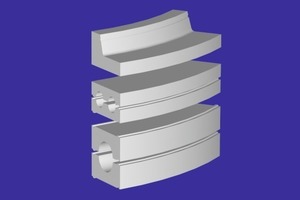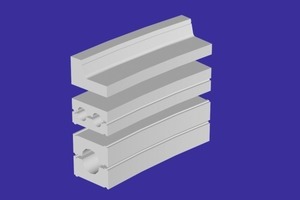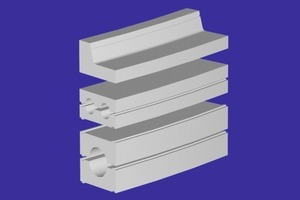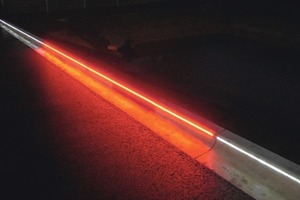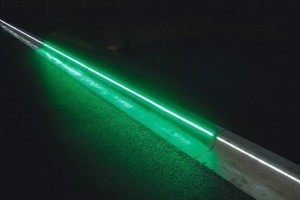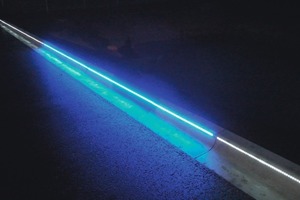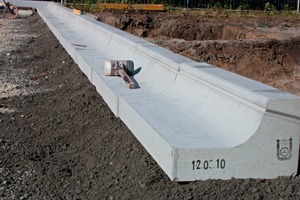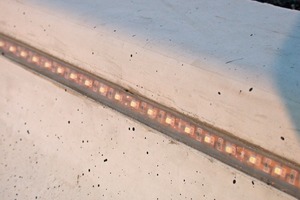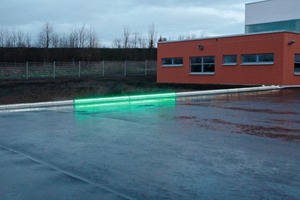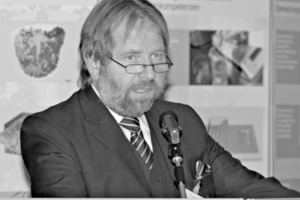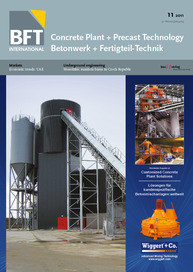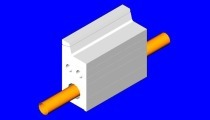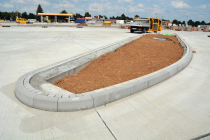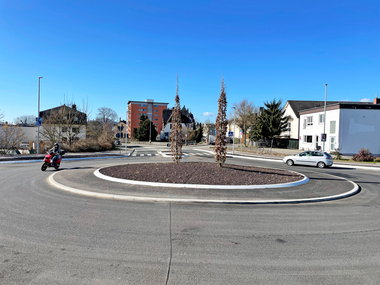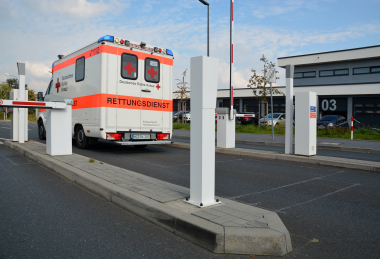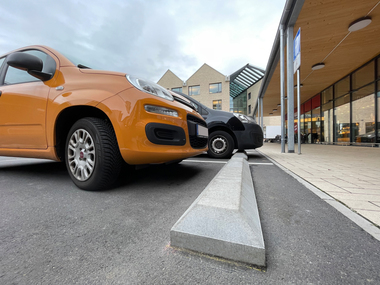A multifunctional curb system
The need for continued alteration of utilities in urban areas due to changing technical and demographic trends and increasingly demanding requirements regarding safety, information and monitoring and maintenance prompted research institutions (IFF Weimar e.V., FITR – Forschungsinstitut für Tief- und Rohrleitungsbau) and precast and construction companies (WBB Straßen- & Tiefbau Marksuhl GmbH, OBB Beton- und Bau GmbH) to join forces in order to develop a multifunctional, retrofittable curb system for the construction of roads, outdoor spaces and tunnels.
The multifunctional curb system provides options to accommodate elements related to infrastructure, safety and communications. Depending on the specific needs traffic management, city information and control systems, telecommunications cables and other technical infrastructure can be integrated. The targeted use of the Multibord system opens up efficient ways to improve traffic safety and to ensure long-term operation and functionality of street spaces. The users of these spaces get all information required for traffic safety in a timely fashion as a result of the curb design and its additional features.
Both, the curb design and additional features should promote self-explanatory street spaces, provide information relevant to traffic safety and ensure continuous traffic flows. In addition, solutions should be implemented to avoid unnecessary street and pavement excavations and to adjust utility routes to current and future requirements. The development of the Multibord system makes it possible to utilize economic resources in the municipal sector by digitally capturing data from municipal service providers, such as street cleaning and waste disposal services, and ensures the creation of an urban communication system.
Integrated utility routes
A large number of utilities with different responsibilities (water, wastewater, gas, electricity and telecommunications) are located within the road profile, which applies especially to urban areas. Combining curbs with storm sewer systems and integrated cable conduits should reduce the load on the underground area affected by construction activity. In the field of telecommunications in particular, the fast-moving market is expected to result in frequently changing requirements for line networks, which requires flexible, fast and cost-efficient solutions for network extensions, repair and maintenance. Conventional curbs hardly provide any possibility to adjust their design to the needs of the service providers. This is where the structural design of the Multibord system offers the required flexibility.
Safety equipment, traffic information systems and telematics
Another aspect to be considered when developing a new generation of curbs is the continuously growing demand for safety/traffic management and telematics systems in public and private traffic areas. Systems integrated in curbs can issue alerts of adverse road conditions (such as ice warnings via temperature sensors, or traffic jam alerts). RFID (Radio Frequency Identification) technology and reading antennas make it possible to integrate monitoring and control systems for municipal service providers and traffic management systems (bollards and barriers).
Lighting and traffic guidance
The curb system provides lighting and guidance features enabled by integrated reflective and fluorescent materials and lighting equipment with self-sufficient energy supply. The curb system thus contributes to improving traffic safety (such as making pedestrian crossings safer or supporting traffic management functions).
Urban areas often include combined traffic spaces shared by vehicles, tramways and cyclists. For instance, 50 to 60% of the accidents in which cyclists are involved are recorded at traffic junctions. Likewise, the safety risk of masts obstructing visibility should not be underestimated.
In this regard, additional measures going beyond the design of tactile curb surfaces are required to improve traffic safety for all road users.
Design and engineering
The Multibord system (Fig. 1) is divided into three levels. Each of these levels is to fulfil specific functions. .
The top level is the curbstone itself and mainly serves to delimit traffic spaces and deflect vehicle wheels, thus fulfilling the basic curb function. This level includes the traffic information system to provide visual information. The system uses transponder to receive this information, and forwards it for further processing.
The center level consists of special-purpose blocks that accommodate cables for information, energy and communications systems. This level can be composed of a varying number of components depending on specific requirements. The number and diameter of integrated conduits can be adjusted to specific functional needs.
The bottom level includes a supplementary module that serves as a stormwater sewer. Tightness is ensured by installing an underground sewer pipe. Manhole units positioned at regular intervals provide access to the tubes for installation, repair and maintenance purposes. The concrete mix designs were tailored to these two methods and meet the specifications for the product to be manufactured.
Due to its modular nature, the curb system can be tailored to specific needs depending on the type of use.
The Multibord range includes straight items with a length of 1,000 mm, radial, transition and flush curbs, and manhole elements. Fig. 2 to 5 show a selection of radial curbs.
The light strips
The curbstone can “communicate” with its environment via light strips that are incorporated in a groove about 3 cm below its top edge. These light strips can transmit visual information to road users in one or several colors. In the simplest scenario, they improve the visibility of white lines. They can also guide the traffic, for instance by highlighting specific road conditions particularly in bends, crossroads or driveways but also on traffic islands (in roundabouts and outside urban areas). Areas with different uses can also be marked accordingly, using unicolored light strips that are available in red, green, blue and white.
Multicolored light strips are suitable for marking specific situations or changing conditions in traffic spaces/areas. Possible colors cover the entire spectrum. For instance, a freely accessible area may be marked in green whereas a blocked or restricted-use area may be highlighted in yellow or red. Energy supply to these systems is ensured by self-sufficient solutions, such as photovoltaic panels. The power required for a light strip equals about 0.5 A/m. At an operating voltage of 12 V, this corresponds to a power consumption of 6 W/m. Fig. 6 shows various operating conditions of the LED lighting system.
Effectiveness/cost efficiency
As a result of its integrated infrastructural, safety, communications and lighting features, the Multibord system not only improves traffic safety and city/service information and control systems. It also makes a contribution to saving operating costs in the long term thanks to its automated monitoring, maintenance and control features and integrated self-sufficient (renewable) energy supply, and as a complement to existing traffic management and signaling systems.
Its use is not just restricted to urban or commercial areas. What is even more significant is the safe and economical design of “dangerous” highway traffic junctions. The curb system can be equipped as required by the user and is thus suitable for a wide range of applications, particularly in tunnels, logistics centers, and commercial areas. A utility model has been registered for the system.
The Multibord system complements the range offered by the concrete products industry. It offers an extended range of features compared to conventional curb systems, which is why it can be adjusted to varying needs. The production process is the same as for conventional curbs. Additional costs should be assumed for laying depending on the functional levels selected. The same applies to the installation of the infrastructural and communications components.
Initial experience with a test track
At the premises of IFF Weimar e.V., a test track was built in 2010 in order to test production processes and laying methods under realistic conditions (Fig. 7). Uni- and multicolored LED strips integrated in the curbstone demonstrate the range of lighting options for illumination and traffic guidance purposes.¢
Project partners:
OBB Beton- und Bau GmbH
Fritz-Bolland-Straße 8
07407 Rudolstadt
WBB Bau- und Beton GmbH
Safransgarten 3
99441 Umpferstedt
Institut für Fertigteiltechnik und Fertigbau Weimar e.V. (Weimar Institute for Precast Technology and Construction)
Über der Nonnenwiese 1
99428 Weimar
Forschungsinstitut für Tief- und Rohrleitungsbau gGmbH
Gutenbergstraße 29a
99423 Weimar

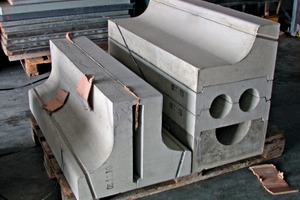
![Fig. 2 Multibord R 2.0 m – A 33.3° – concave [R=radius; A=segment angle]](https://www.bft-international.com/imgs/tok_d89af79f303edcde466fcaad168a2d4a/w300_h200_x400_y191_103951456_0aa7393c8a.jpg)
